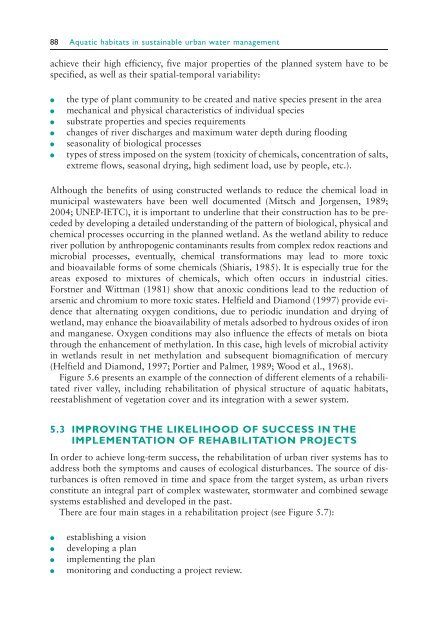Aquatic Habitats In Sustainable Urban Water Management
Aquatic Habitats In Sustainable Urban Water Management
Aquatic Habitats In Sustainable Urban Water Management
- No tags were found...
Create successful ePaper yourself
Turn your PDF publications into a flip-book with our unique Google optimized e-Paper software.
88 <strong>Aquatic</strong> habitats in sustainable urban water management<br />
achieve their high efficiency, five major properties of the planned system have to be<br />
specified, as well as their spatial-temporal variability:<br />
●<br />
●<br />
●<br />
●<br />
●<br />
●<br />
the type of plant community to be created and native species present in the area<br />
mechanical and physical characteristics of individual species<br />
substrate properties and species requirements<br />
changes of river discharges and maximum water depth during flooding<br />
seasonality of biological processes<br />
types of stress imposed on the system (toxicity of chemicals, concentration of salts,<br />
extreme flows, seasonal drying, high sediment load, use by people, etc.).<br />
Although the benefits of using constructed wetlands to reduce the chemical load in<br />
municipal wastewaters have been well documented (Mitsch and Jorgensen, 1989;<br />
2004; UNEP-IETC), it is important to underline that their construction has to be preceded<br />
by developing a detailed understanding of the pattern of biological, physical and<br />
chemical processes occurring in the planned wetland. As the wetland ability to reduce<br />
river pollution by anthropogenic contaminants results from complex redox reactions and<br />
microbial processes, eventually, chemical transformations may lead to more toxic<br />
and bioavailable forms of some chemicals (Shiaris, 1985). It is especially true for the<br />
areas exposed to mixtures of chemicals, which often occurs in industrial cities.<br />
Forstner and Wittman (1981) show that anoxic conditions lead to the reduction of<br />
arsenic and chromium to more toxic states. Helfield and Diamond (1997) provide evidence<br />
that alternating oxygen conditions, due to periodic inundation and drying of<br />
wetland, may enhance the bioavailability of metals adsorbed to hydrous oxides of iron<br />
and manganese. Oxygen conditions may also influence the effects of metals on biota<br />
through the enhancement of methylation. <strong>In</strong> this case, high levels of microbial activity<br />
in wetlands result in net methylation and subsequent biomagnification of mercury<br />
(Helfield and Diamond, 1997; Portier and Palmer, 1989; Wood et al., 1968).<br />
Figure 5.6 presents an example of the connection of different elements of a rehabilitated<br />
river valley, including rehabilitation of physical structure of aquatic habitats,<br />
reestablishment of vegetation cover and its integration with a sewer system.<br />
5.3 IMPROVING THE LIKELIHOOD OF SUCCESS IN THE<br />
IMPLEMENTATION OF REHABILITATION PROJECTS<br />
<strong>In</strong> order to achieve long-term success, the rehabilitation of urban river systems has to<br />
address both the symptoms and causes of ecological disturbances. The source of disturbances<br />
is often removed in time and space from the target system, as urban rivers<br />
constitute an integral part of complex wastewater, stormwater and combined sewage<br />
systems established and developed in the past.<br />
There are four main stages in a rehabilitation project (see Figure 5.7):<br />
●<br />
●<br />
●<br />
●<br />
establishing a vision<br />
developing a plan<br />
implementing the plan<br />
monitoring and conducting a project review.















